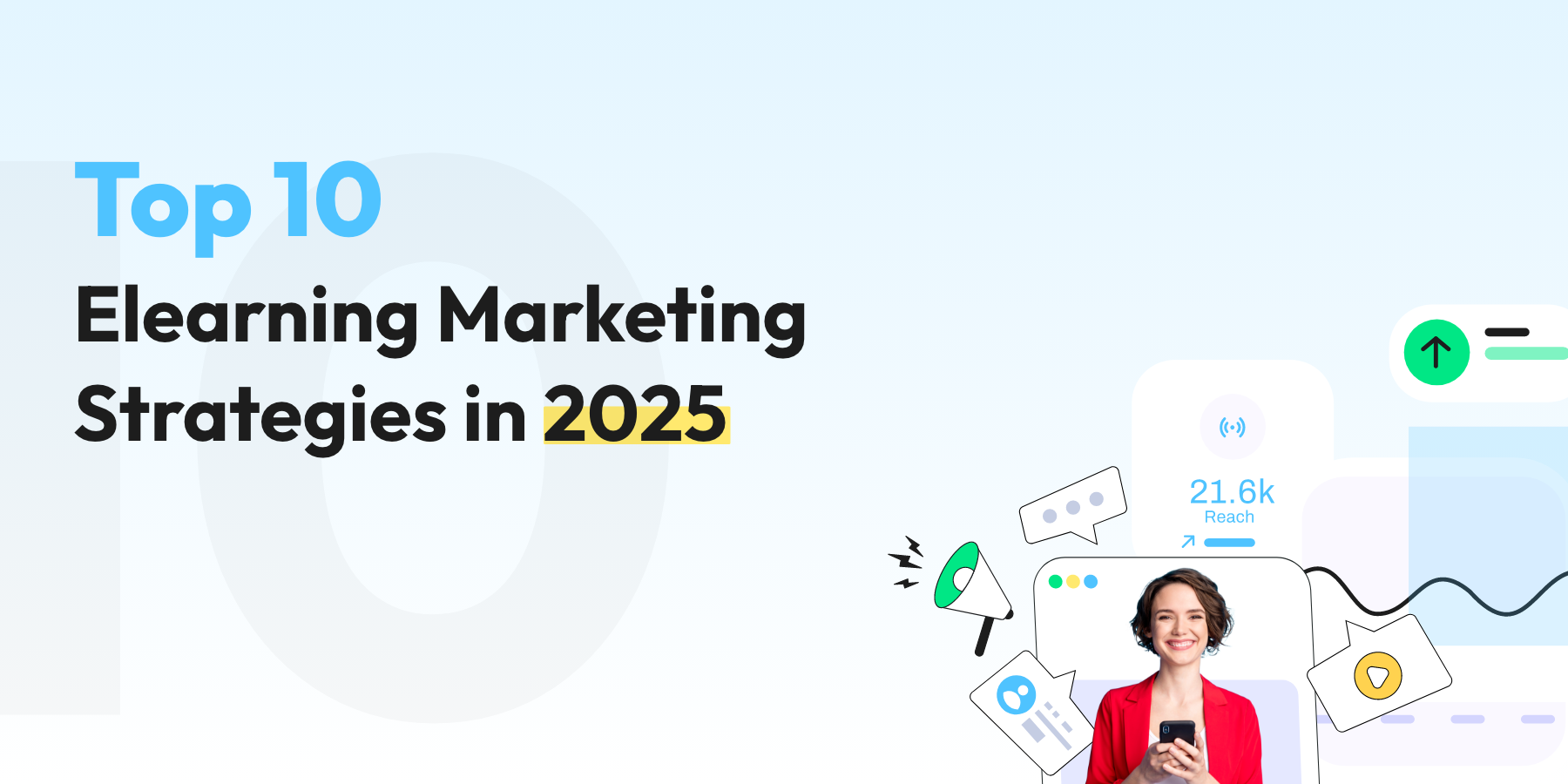
Top 10 Elearning Marketing Strategies in 2025
Written by: Bhavyadeep Sinh Rathod | on: October 4, 2024 | Last updated on: December 27, 2024 | According to: Editorial Policies
Imagine your e-learning business as a gourmet dish. You’ve got premium ingredients (your expertise), a perfect blend of flavors (engaging content), and a chef’s kiss presentation (slick course design). But here’s the million-dollar question: is your restaurant full? Is your virtual classroom buzzing with activity? If your course sign-ups are lagging, it’s time to revamp your elearning marketing strategy.
In this article, we’re unveiling 10 powerful elearning marketing techniques, tailor-made for e-learning entrepreneurs like you who are ready to scale their impact. From leveraging the high engagement rates of WhatsApp to harnessing the persuasive power of student success stories, we’ve got all the essential tools to transform your courses into must-have learning experiences.
Ready to become a trendsetter in online education? Let’s dive in and take your e-learning business to new heights!
1. Leverage WhatsApp Marketing
WhatsApp boasts an impressive 98% open rate for messages. This means that when you reach out to potential students, they’re likely to see and read your message. Compare this to email marketing, where open rates often hover around 20-30%, and you can see why WhatsApp is a game-changer for e-learning marketing.
But that’s not the only reason why WhatsApp is ideal for e-learning businesses.
Here are some more:
- Instant Communication: WhatsApp allows for real-time interaction, perfect for answering quick questions about courses or providing immediate support to students.
- Rich Media Sharing: Easily share images, videos, and documents, making it simple to give course previews or share study materials.
- Group Chats: Create WhatsApp communities and groups where students can collaborate and support each other.
- Voice and Video Calls: Offer one-on-one tutoring sessions or small group discussions directly through the app.
- Global Reach: With almost 3 billion users worldwide, WhatsApp helps you connect with learners across different countries and time zones.
- Cost-Effective: WhatsApp is free to use, making it a budget-friendly option for marketing and communication.
- Mobile-First: As per a study, 71% of millennials prefer learning on mobile devices over desktops or traditional classrooms. WhatsApp’s mobile-friendly design fits perfectly with this trend, making it easy for students to engage with your e-learning content on the go.
- Personalization: Use WhatsApp to send personalized course recommendations or study tips based on a student’s interests or progress.
For e-learning businesses like you looking to scale their WhatsApp marketing efforts, the WhatsApp Business API offers even more powerful features.
Let’s have a look at them one by one.
a. Broadcasts and Announcements
WhatsApp’s broadcast feature is a powerful tool for you to reach audiences. Here’s how you can leverage it effectively:
i. Announcing New Courses:
- Share course outlines, learning outcomes, and instructor bios
- Include a short video teaser to spark interest
- Offer early-bird discounts for quick sign-ups
WhatsApp’s broadcast feature is a powerful tool for you to reach audiences. Here’s how you can leverage it effectively:
ii. Limited-Time Offers:
- Offer bundled complementary courses for for a limited time
- Offer exclusive bonuses for WhatsApp subscribers for a short period
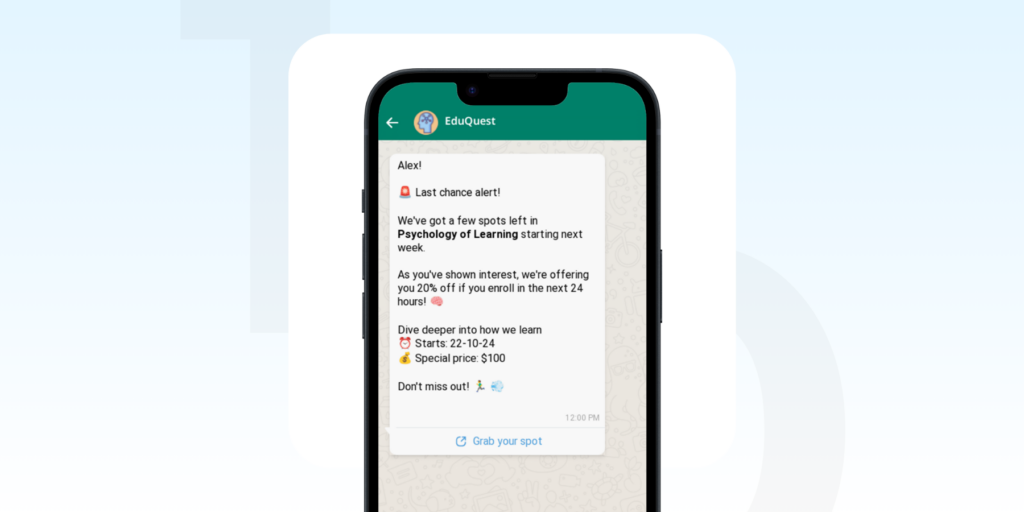
iii. Webinar Reminders:
- Send a series of reminders (1 week, 1 day, 1 hour before)
- Include a brief agenda to build excitement
- Encourage participants to prepare questions in advance
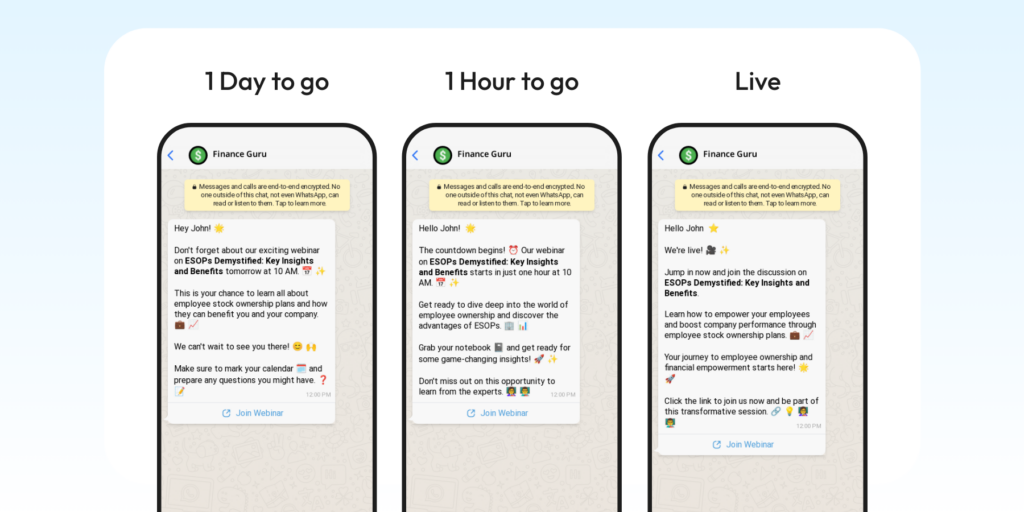
Also Read: How to Increase Webinar Attendance With WhatsApp Marketing
iv. Course Sneak Peeks:
- Share a free lesson or module from a paid course
- Include student testimonials or success stories
- Offer a limited-time discount for those who sign up after the sneak peek
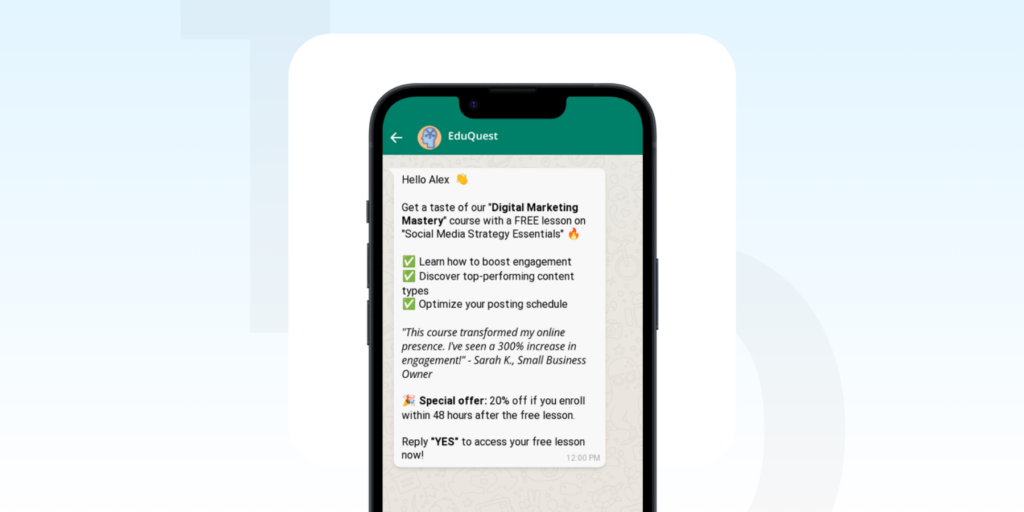
v. Industry News and Updates:
- Position your brand as a thought leader
- Relate news to your courses to show relevance
- Encourage discussion in your WhatsApp groups
vi. Student Achievements:
- Celebrate student successes to motivate others
- Share case studies of how your courses have helped learners
- Encourage current students to invite friends (referral program)
Remember to segment your audience based on interests, course history, or learning goals to ensure your broadcasts remain relevant and engaging.
b. Automated Reminders
Automated reminders can significantly boost attendance and engagement.
Here’s how to make them more effective:
i. One Day Before the Class:
- Include a brief overview of what will be covered
- Remind students to prepare any necessary materials
- Provide a link to pre-class reading or exercises
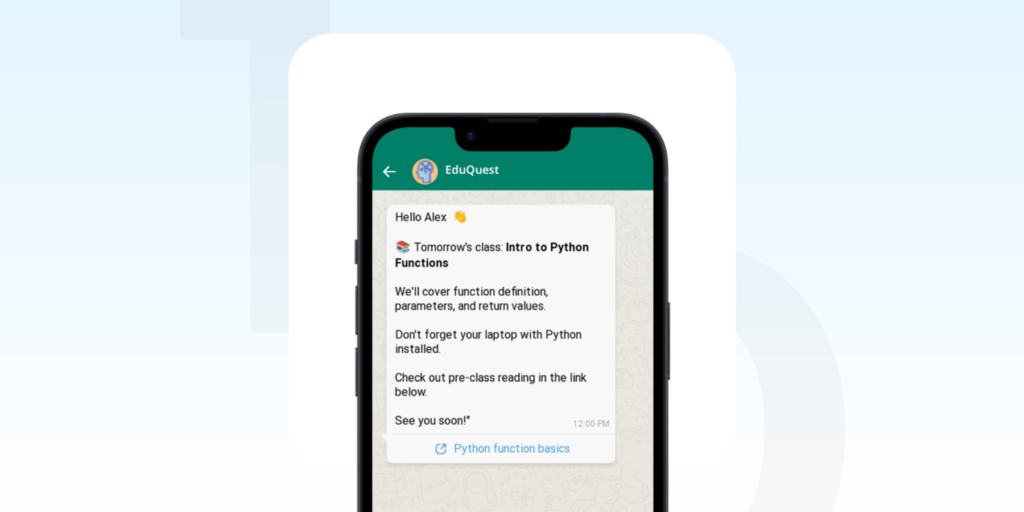
ii. One Hour Before the Class Starts:
- Send a friendly nudge with the class link
- Include a quick tip or fact related to the upcoming lesson
- Remind students of the value they’ll gain from attending
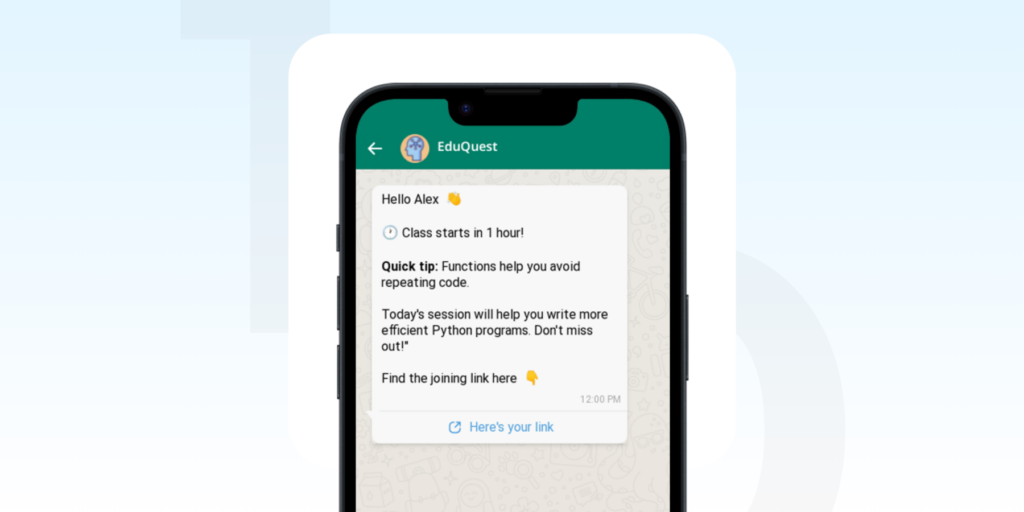
iii. When the Class Goes Live:
- Share the live link with a welcoming message
- Mention any exciting activities or discussions planned
- Encourage prompt joining to not miss important information
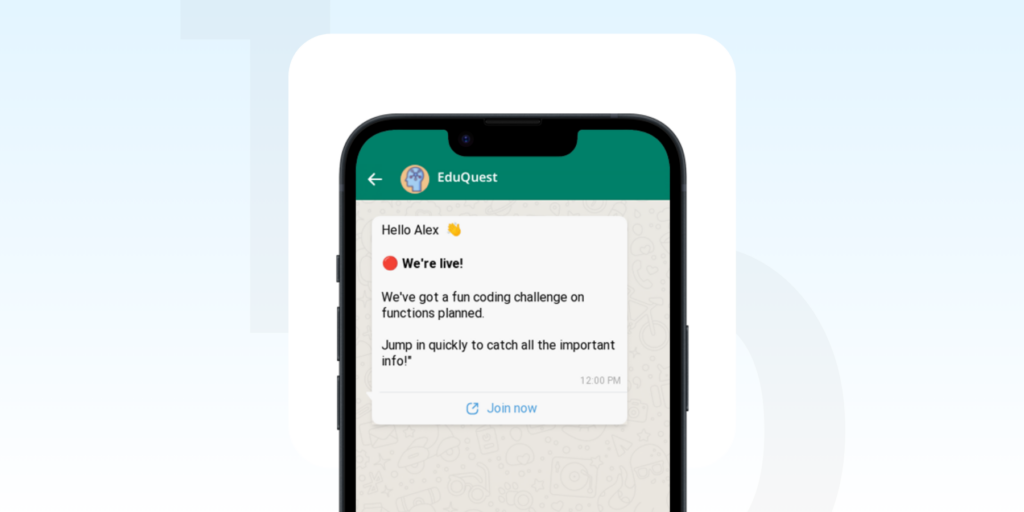
iv. Post-Class Follow-up:
- Send a summary of the key points covered
- Share any homework or practice exercises
- Ask for feedback to improve future sessions
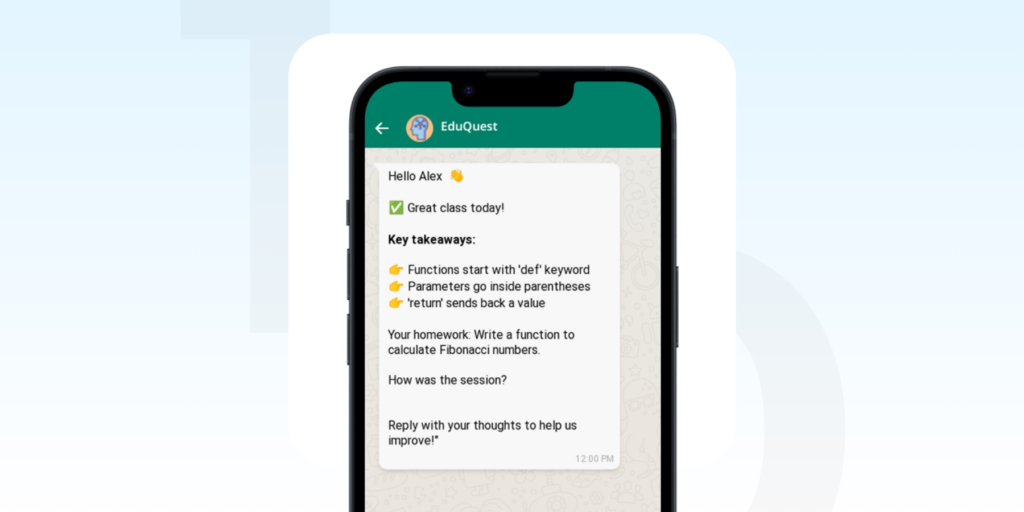
v. Missed Class Reminder:
- Reach out to absent students with a caring message
- Provide a recap and any materials they missed
- Offer a way to catch up (recording, extra help session, etc.)
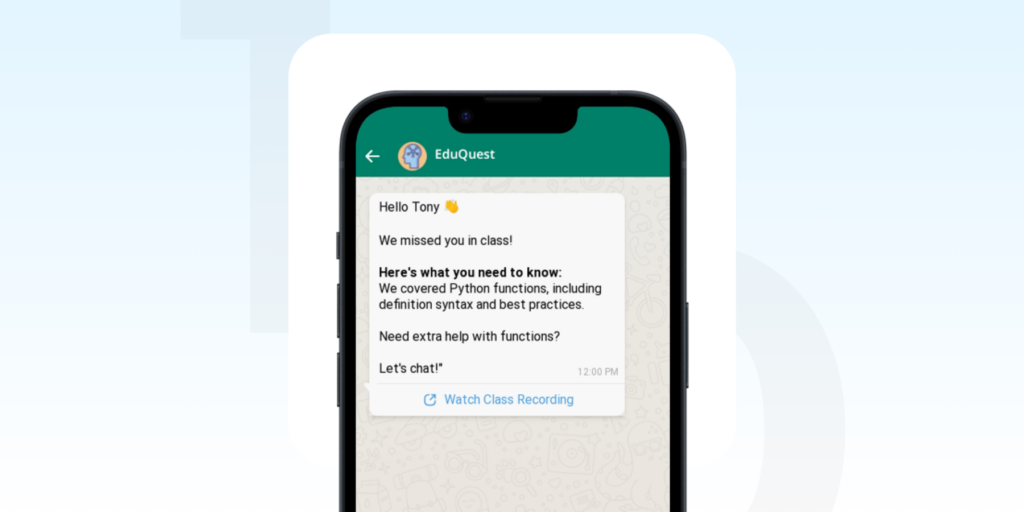
💡Pro Tip: Use WhatsApp’s API to integrate these reminders with your Learning Management System (LMS). This allows for automated, personalized reminders based on each student’s enrolled courses and progress.
c. Click-to-WhatsApp Ads
Combine the power of Facebook and Instagram ads with the personal touch of WhatsApp. Run Click-to-WhatsApp ads on platforms like Facebook and Instagram. When someone clicks on your CTWA ad, it opens a WhatsApp chat with your business. This direct line of communication can dramatically increase your conversion rates.
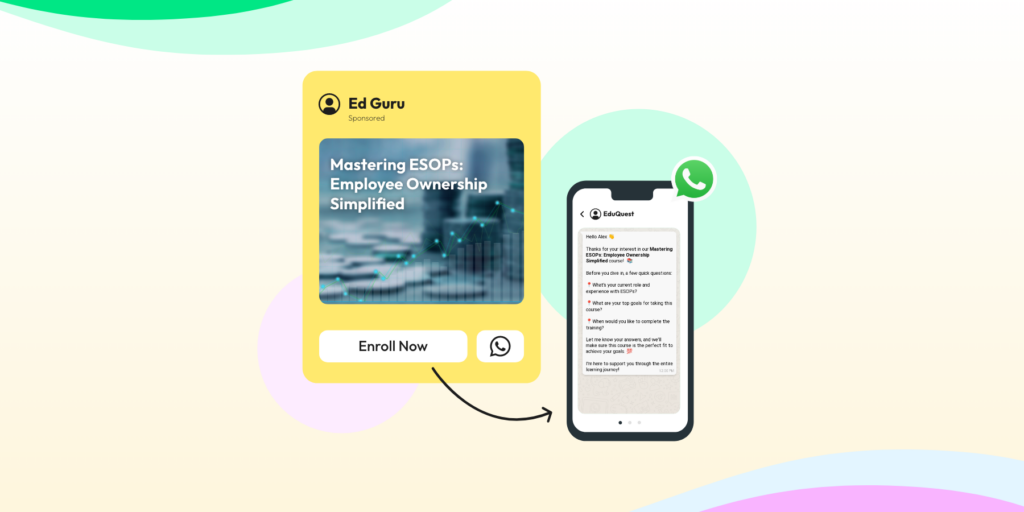
By leveraging WhatsApp elearning, you can create a more personal connection with their audience, boost engagement, and ultimately increase course enrollments.
To know how easy it is to setup CTWA Ads with Wati, watch this video 👇
That’s not it, we have an entire CTWA playlist on YouTube that helps you know:
- CTWA advantages
- CTWA best practices
- Measuring & optimizing CTWA
💡Pro Tip: Set up a WhatsApp chatbot to handle initial inquiries 24/7. This way, you can qualify leads and answer common questions even when you’re not available, ensuring you never miss an opportunity to connect with a potential student.
2. Optimize Free Webinars and Workshops as Lead Magnets
Free webinars are one of the evergreen elearning marketing strategies which, done right, can bring in great results for your elearning business. To get most of them, it’s important to look at these webinars as powerful lead magnets.

You can follow the below steps to ensure a successful free webinar:
- Craft compelling topics addressing audience pain points
- Optimize landing pages with clear benefits and easy registration
- Promote across multiple channels (email, social media, partnerships)
- Keep attendees engaged with polls and Q&A sessions
- Offer valuable insights and special discounts on paid courses
- Send thank-you emails with nurture sequences
- Leverage WhatsApp marketing for higher engagement
Also Read: How to Increase Webinar Attendance
💡Pro Tip: Use Click-to-WhatsApp ads for instant engagement!
You can also ensure your webinar’s success with Wati to:
- Set automated reminders using the Sequence feature
- Use Broadcast Analytics to measure success
By providing genuine value through your free webinar, you can naturally guide potential students towards your paid offerings.
3. Harness Influencer Marketing
You can tap into Influencer Networks by partnering with influencers who align with your e-learning niche. To find these influencers, you can go to influencer marketplaces like Upfluence and Creator.co. These platforms offer a vast pool of potential collaborators across various industries and expertise levels.

When selecting influencers for your e-learning business:
- Focus on those whose audience matches your target learners
- Look beyond follower count – prioritize engagement rates and content quality
- Consider micro-influencers in your specific field
- Seek out influencers with highly engaged audiences passionate about your subject matter
Once you’ve identified potential partners, develop a collaborative strategy:
- Have influencers create content about your courses
- Host joint webinars to showcase expertise and course offerings
- Offer exclusive discounts to the influencer’s followers
- Ensure the partnership feels natural and valuable to the influencer’s audience
- Prioritize authenticity over promotional pushes
Remember, the goal is to create genuine connections that benefit both your e-learning business and the influencer’s audience.
💡Pro Tip: Implement a “Try Before You Buy” strategy with your influencer partnerships. Offer influencers free access to your course or a custom mini-course before they promote it. This approach serves two purposes:
It allows influencers to genuinely experience and understand your offering, leading to more authentic promotions.
If they share their learning journey on social media, it creates organic, engaging content that can spark interest among their followers.
This strategy not only builds trust with influencers but also provides potential students with a vicarious preview of your course, potentially boosting enrollment rates.
4. Create Founder-Led Content
As an e-learning business owner, you have a unique opportunity to leverage your expertise and personal brand. Founder-led content can be a powerful tool for building trust and attracting potential students. Here’s how to make it work:
Share Your Journey: Tell the story of why you started your e-learning business. What challenges did you face? How did you overcome them?
Offer Behind-the-Scenes Glimpses: Show your audience what goes into creating your courses. This transparency can build credibility and interest.
Provide Expert Tips: Share quick, actionable advice related to your course topics. This demonstrates your knowledge and gives value to your audience.
Go Live: Host regular live Q&A sessions on social media. This real-time interaction can help build a strong connection with your audience.
Write Personal Blog Posts: Share your thoughts on industry trends or lessons you’ve learned. This can position you as a thought leader in your field.
Remember, authenticity is key. Let your personality shine through in your content to create a genuine connection with your audience.
💡Pro Tip: Create a “day in the life” video series featuring your founder. Show them crafting course content, problem-solving, and interacting with students. This behind-the-scenes look humanizes your brand and showcases the expertise behind your courses, building trust and connection with potential learners.
5. Implement Multi-Channel Digital Marketing
To reach more potential students, e-learning businesses should use various digital marketing channels. Here’s how:
Social Media Magic: Share snippets of your courses on platforms like Instagram and LinkedIn. Post helpful tips, behind-the-scenes content, and student success stories to spark interest.
Email Engagement: Build an email list and send regular newsletters with course updates, special offers, and valuable content. Use catchy subject lines to boost open rates.
SEO for Visibility: Optimize your website and course descriptions with relevant keywords. Create blog posts and videos that answer common questions in your field to attract organic traffic.
Paid Advertising: Run targeted ads on Google and social media platforms to reach people actively searching for online courses in your niche.
By combining these strategies, you’ll create a strong online presence and attract more learners to your e-learning platform.
6. Utilize Limited-Time Offers and Urgent Promotions for Course Enrollments
You can boost your e-learning course enrollments by leveraging the power of urgency and scarcity.
How? Let’s see.
- Create time-sensitive offers that compel potential students to take immediate action. For instance, offer an early bird discount for the first 50 enrollments or a 24-hour flash sale with a significant price reduction.
- Use countdown timers on your landing pages and in email campaigns to heighten the sense of urgency.
- Implement seasonal promotions tied to holidays or academic calendars to tap into natural buying cycles.
- Consider bundling courses or offering exclusive bonuses for a limited time to increase perceived value.
Use WhatsApp broadcasts to announce these promotions, ensuring high visibility with its 98% open rate.
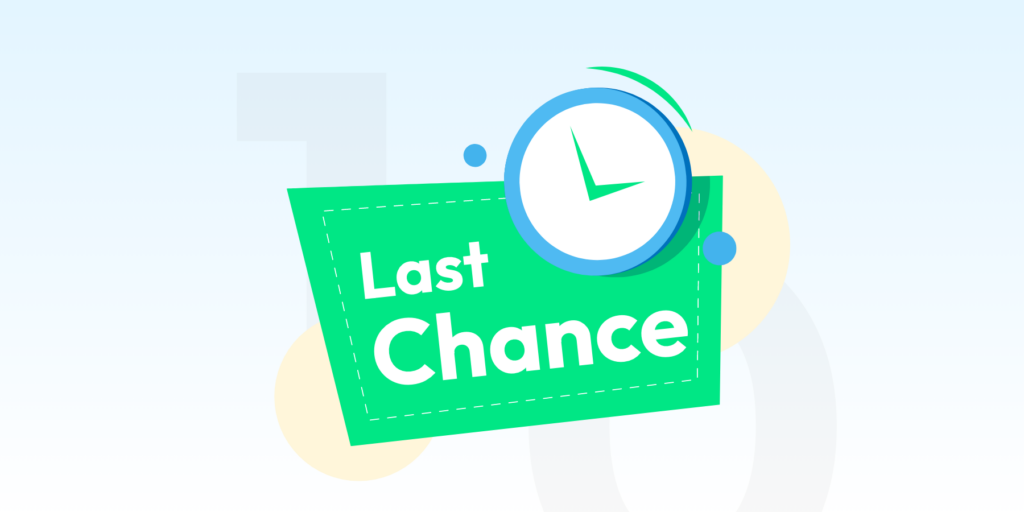
Remember to clearly communicate the value proposition and deadline in all marketing materials. This strategy not only drives quick enrollments but also creates a buzz around your e-learning platform.
💡Pro Tip: Use Wati’s Sequence feature to set up automated WhatsApp reminders for your limited-time offers. Send messages 24 hours before the deadline, 1 hour before the deadline, and when the promotion goes live to maximize engagement and conversions.
7. Showcase Student Success Stories and Course Testimonials
One of the best ways to attract new students is by showing off your current students’ wins. Think of it as bragging about your students’ awesome achievements!
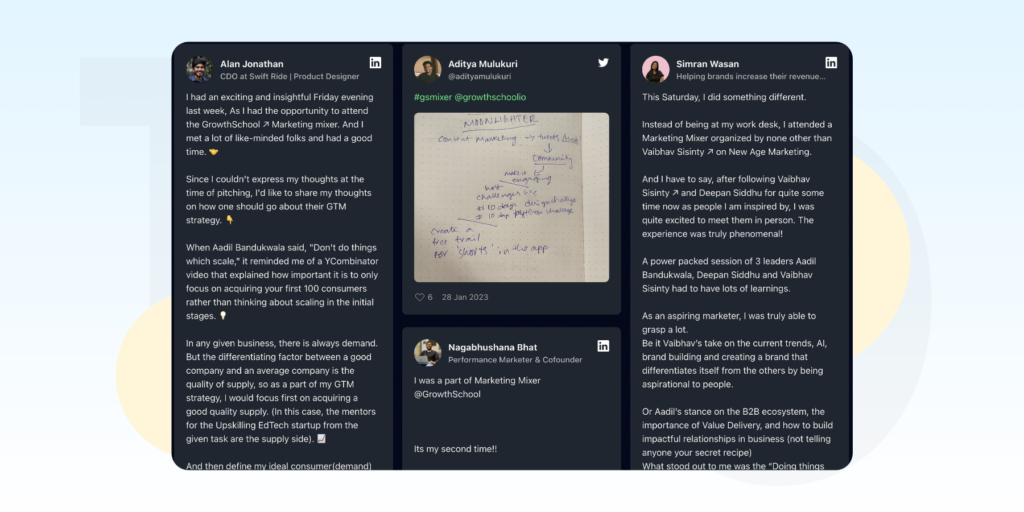
Share Success Stories
Pick out some of your best students and tell their stories. Did someone land their dream job after taking your course? Or maybe they started a successful business? Share these exciting tales on your website and social media.
Use Real Student Reviews
Ask your happy students to write about their experiences. Then, put these reviews where new students can easily see them. You could add them to your course pages or create a special testimonials section on your website.
Make It Visual
Don’t just stick to words. Use pictures of your successful students or even short videos where they talk about how your course helped them. This makes the stories feel more real and exciting to potential new students.
💡Pro Tip: Use a tool like Bonjoro to send personalized video congratulations to course graduates. In the video, ask them to share their success story. This personal touch often leads to more detailed and heartfelt testimonials that you can use (with permission) in your marketing.
8. Implement Student Referral Programs
Boost your e-learning business by tapping into your students’ networks! A well-designed referral program can be a powerful tool for attracting new learners.
Here’s how to make it work:
- Offer Incentives: Give both the referrer and the new student a reward, like a discount on their next course or exclusive content.
- Make it Easy: Provide shareable links or codes that students can quickly send to friends.
- Track and Reward: Use your learning management system to monitor referrals and automatically apply rewards.
- Promote Success Stories: Share testimonials from students who’ve benefited from referrals to inspire others.
- Time it Right: Launch your referral program during peak enrollment periods for maximum impact.
Remember, word-of-mouth marketing is incredibly powerful in the e-learning industry. Happy students are your best ambassadors!
💡Pro Tip: Create a leaderboard to gamify your referral program. Offer special prizes or recognition to top referrers, turning the process into a fun competition among your students.
9. Use Retargeting Campaigns for Abandoned Course Signups
Step 1: Set Up Tracking
Before launching any retargeting campaigns, ensure you have proper tracking in place:
- Install tracking pixels:
- Set up event tracking:
- Course page views
- Add to cart actions
- Initiated checkouts
- Abandoned carts
- Create custom audiences based on these events in each ad platform.
Step 2: Segment Your Audience
Break down your audience based on their behavior:
- Course viewers: Those who viewed course details but didn’t add to cart
- Cart abandoners: Users who added a course to cart but didn’t start checkout
- Checkout abandoners: Those who began the checkout process but didn’t complete it
Step 3: Design Your Campaign Structure
Create a multi-channel approach:
- Social Media Retargeting:
- Facebook & Instagram Ads
- LinkedIn Ads (especially for professional courses)
- Display Retargeting:
- Google Display Network
- YouTube video ads
- Search Retargeting:
- Google Search Ads with RLSA (Remarketing Lists for Search Ads)
- Email Retargeting:
- Abandoned cart email sequences
- WhatsApp Retargeting:
- Personalized messages via WhatsApp Business API
Step 4: Craft Your Messaging
Tailor your ad content based on the audience segment and the time since abandonment:
- Course Viewers (1-3 days after viewing):
- Highlight key course benefits
- Share student testimonials
- Offer a free sample lesson
- Cart Abandoners (1-5 days after abandonment):
- Remind them of the course in their cart
- Address common objections (e.g., “Not sure if this is right for you?”)
- Offer a limited-time discount
- Checkout Abandoners (1-7 days after abandonment):
- Ask if they had any issues during checkout
- Provide easy links to resume registration
- Offer a bonus (e.g., “Complete your registration now and get an exclusive e-book!”)
Step 5: Implement WhatsApp Marketing
Leverage WhatsApp’s high engagement rates:
- Set up Click-to-WhatsApp ads on Facebook and Instagram.
- Create a WhatsApp chatbot to handle initial inquiries and guide users back to registration.
- Use WhatsApp broadcasts to send personalized reminders about abandoned courses.
- Offer live chat support via WhatsApp to address any concerns or questions.
Step 6: Optimize for Mobile
Ensure all your retargeting efforts are mobile-friendly:
- Create mobile-specific ad creatives
- Use mobile-friendly landing pages
- Implement one-click signup options where possible
- Use push notifications if you have a mobile app
💡Pro Tip: Use Wati’s WhatsApp Business API solution to supercharge your retargeting efforts. With Wati, you can:
👉 Set up automated reminder sequences on WhatsApp
👉 Use broadcast messages for time-sensitive offers
👉 Implement a chatbot to handle FAQs and guide users back to registration
👉 Analyze message performance with detailed analytics
Remember, the key to successful retargeting is to provide value and address potential concerns, not just repeatedly push for a sale. By implementing this comprehensive strategy and leveraging the power of WhatsApp marketing with Wati, you can significantly boost your course signup completion rates and grow your e-learning business.
10. Create Affiliate Programs for Course Promotions
Affiliate programs are a powerful e-learning marketing strategy for several reasons. They help you reach new audiences, leverage the trust others have built with their followers, and only cost you money when they actually make a sale. This makes them a low-risk, high-reward option for promoting your online courses.

Here’s how to set up an effective affiliate program:
- Choose your affiliates: Look for people who love your courses or have a following in your field.
- Set up rewards: Decide how much you’ll pay affiliates when they bring in new students.
- Give them tools: Provide special links, banners, or discount codes for affiliates to share.
- Track performance: Use software to see which affiliates are bringing in the most students.
- Support your team: Help your affiliates succeed by giving them tips and updates about your courses.
By implementing an affiliate program, you can expand your reach and grow your e-learning business faster, all while maintaining control over your marketing costs.
💡Pro Tip: Consider offering tiered commissions. Give higher rewards to affiliates who bring in more students. This can motivate them to work harder at promoting your courses.

Conclusion
As we’ve explored in this guide, the e-learning marketing landscape offers a wealth of innovative strategies to boost your course visibility and enrollment. From leveraging the impressive 98% open rate of WhatsApp marketing to optimizing free webinars as powerful lead magnets, these tactics can significantly enhance your engagement with potential students. Harnessing influencer partnerships, creating compelling founder-led content, and implementing smart retargeting campaigns form a robust toolkit that can truly transform your marketing efforts. The key is to implement these strategies in a way that aligns with your unique brand and resonates with your target audience.
Remember, the e-learning market is projected to reach $457.8 billion by 2026, and these marketing strategies position you to capture a share of this expanding market. As you move forward, approach your marketing as an ongoing process of learning and refinement. Start with the strategies that best fit your business model, then gradually incorporate others as you grow. With these powerful tools at your disposal, you’re well-equipped to transform your e-learning business into a thriving success story. The digital classroom is waiting for your mark – so go forth and let your courses shine!
Frequently Asked Questions
1. What are some common pitfalls to avoid when first starting with WhatsApp marketing for e-learning businesses?
Avoid over-messaging, neglecting personalization, ignoring local regulations, and failing to segment your audience. Also, ensure you have a clear opt-in process and respect users’ privacy preferences.
2. How can small e-learning businesses with limited budgets prioritize which of these marketing strategies to implement first?
Start with low-cost, high-impact strategies like WhatsApp marketing, content creation, and referral programs. As you grow, gradually incorporate paid advertising and influencer partnerships.
3. Are there any legal considerations or regulations to be aware of when using student testimonials or success stories in marketing materials?
Yes, obtain written consent from students before using their testimonials. Ensure claims are truthful and can be substantiated. Be aware of privacy laws like GDPR when handling student data.
4. How can e-learning businesses measure the ROI of their marketing efforts, particularly for strategies like influencer partnerships or affiliate programs?
Track key metrics such as Cost Per Acquisition (CPA), conversion rates, and Lifetime Value (LTV) of students. Use unique tracking links or promo codes for each campaign to accurately attribute enrollments to specific marketing efforts.





Latest Comments